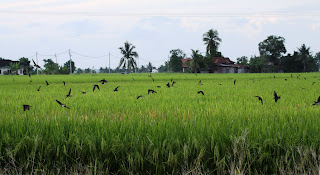"We'll be here for awhile."



Choosing wide open unbroken ricefields to circle around and within, they glide low and slow, sometimes landing on flimsy rice plants and vanish amongst the tall reeds.
1. Pied harrier, female.
2. Eastern Harrier, female
3. Pied Harrier, female. male is seen making rounds even further.
4. Western Harrier? Female
Remain in ricefields, all day long. Possibly three species, in family groups of male, female and juveniles. At dusk, all of them would actively take to the field simultaneously, numbering at least 8.









